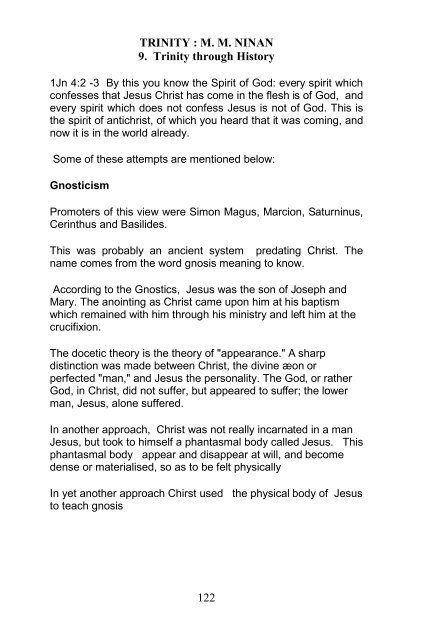Christian Understanding of Trinity3
Create successful ePaper yourself
Turn your PDF publications into a flip-book with our unique Google optimized e-Paper software.
TRINITY : M. M. NINAN<br />
9. Trinity through History<br />
1Jn 4:2 -3 By this you know the Spirit <strong>of</strong> God: every spirit which<br />
confesses that Jesus Christ has come in the flesh is <strong>of</strong> God, and<br />
every spirit which does not confess Jesus is not <strong>of</strong> God. This is<br />
the spirit <strong>of</strong> antichrist, <strong>of</strong> which you heard that it was coming, and<br />
now it is in the world already.<br />
Some <strong>of</strong> these attempts are mentioned below:<br />
Gnosticism<br />
Promoters <strong>of</strong> this view were Simon Magus, Marcion, Saturninus,<br />
Cerinthus and Basilides.<br />
This was probably an ancient system predating Christ. The<br />
name comes from the word gnosis meaning to know.<br />
According to the Gnostics, Jesus was the son <strong>of</strong> Joseph and<br />
Mary. The anointing as Christ came upon him at his baptism<br />
which remained with him through his ministry and left him at the<br />
crucifixion.<br />
The docetic theory is the theory <strong>of</strong> "appearance." A sharp<br />
distinction was made between Christ, the divine æon or<br />
perfected "man," and Jesus the personality. The God, or rather<br />
God, in Christ, did not suffer, but appeared to suffer; the lower<br />
man, Jesus, alone suffered.<br />
In another approach, Christ was not really incarnated in a man<br />
Jesus, but took to himself a phantasmal body called Jesus. This<br />
phantasmal body appear and disappear at will, and become<br />
dense or materialised, so as to be felt physically<br />
In yet another approach Chirst used the physical body <strong>of</strong> Jesus<br />
to teach gnosis<br />
122


















